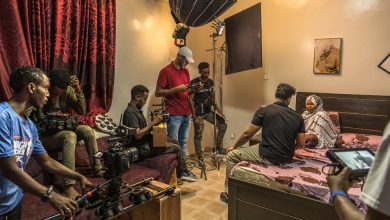Is New York Headed for a Higher Covid Risk Level?

Good morning. It’s Thursday. We’ll look at why New York City may raise its Covid-19 risk level soon. We’ll also look at why only a fraction of the aid promised by government officials has reached survivors of a fire in a Bronx high-rise in January.

Credit…Hiroko Masuike/The New York Times
Is this another here-we-go-again moment in the coronavirus pandemic?
With Manhattan and Staten Island reporting more than 200 new cases per 100,000 residents per week and Brooklyn and Queens approaching that threshold, the city could be close to raising its risk level from green to yellow.
But those numbers were not the only potential trouble signs in the last 24 hours. Gov. Kathy Hochul warned that the state could be seeing the beginning of another spike in cases.
New infections and hospitalizations have been trending upward, she said — a troubling but not unexpected development since the emergence of two Omicron subvariants, BA.2.12 and BA.2.12.1. They now account for the majority of Covid-19 cases statewide.
“We’re not panicking,” Hochul said, noting that case counts were still well below their levels at the height of the Omicron surge. Still, as she acknowledged, that surge began with modest increases like the ones being reported now, only to be followed by a precipitous jump.
“We’re not expecting that to happen here,” she said. “But on the other hand, we don’t know.”
She refrained from introducing new restrictions, and Mayor Eric Adams — back at City Hall this week after testing positive on April 10 and isolating at Gracie Mansion — also appears reluctant to bring them back.
Green now, but yellow soon?
The city’s color-coded alert system is still relatively new. Introduced in March, it relies on parameters set by the Centers for Disease Control and Prevention and takes into account hospitalizations, unlike the system the C.D.C. has used for much of the pandemic. Under the old system, the city and most of the Northeast would be considered a red or high-transmission zone.
A risk level of green under the new system means that community spread of Covid-19 is “lower.”
As long as there are fewer than 200 new Covid-19 cases per 100,000 residents per week in the city and hospitalizations also remain low, the alert level stays green. The alert level rises to yellow — a medium risk level — if new cases reach 200 per 100,000 residents, even with low hospitalizations.
The city recorded 193.97 new cases per 100,000 people during the week that ended April 16. By comparison, there were about 160 cases per 100,000 per week in New York City during the Delta surge last summer and fall, and about 3,300 cases per 100,000 per week in New York City at the peak of the Omicron surge in early January.
Hospitalization levels, while still low, have also started to creep up, but only 2.21 percent of the city’s hospital beds were occupied by Covid-19 patients.
Manhattan, which has had more than 300 new cases per 100,000 people per week since April 8, has been at the yellow alert level for more than three weeks. Staten Island crossed into yellow on Tuesday. My colleague Sharon Otterman writes that the city did not publicize those shifts because it uses only one alert level for the entire city, and the other boroughs have so far remained green.
Some experts suspect there are far more cases than the alert system is counting, in part because it does not take into account home testing. Dr. Denis Nash, a professor of epidemiology at the City University of New York who studied transmission trends during the city’s first Omicron surge, suspects the number of infections is “probably three to five times” the number of cases being diagnosed.
Weather
Enjoy a mostly sunny day with a high in the low 60s. In the evening, expect wind gusts and temps in the low 50s.
alternate-side parking
Suspended today (Holy Thursday, Orthodox) and tomorrow (Passover and Good Friday, Orthodox).
The latest Metro news
Crime
-
Federal law enforcement charged a New Jersey man with hate crimes for a violent attack on four Jewish men, in which two were hit by a vehicle that had been carjacked from the first victim.
-
A white Connecticut state trooper who fatally shot a 19-year-old Black man after a car chase two years ago has been charged with manslaughter.
Other big stories
-
The Diocese of Camden agreed to pay $87.5 million to settle claims made by hundreds of people who accused clergy members of sexually abusing them.
Survivors of Bronx fire say assistance comes slowly
It’s been nearly four months since a fire spread through Twin Parks North West, a high-rise apartment building in the Bronx, killing 17 people. Residents want to know when they will see money from a $4.4 million city-managed donation fund.
Two of my colleagues, Kimiko de Freytas-Tamura and Karen Zraick, write that elected officials rallied, and donations poured in from the community. But only a fraction of the aid promised by government officials has trickled down to survivors. “Waiting for the money has been like waiting for Godot,” said Representative Ritchie Torres, who represents part of the Bronx.
In January, Mayor Eric Adams and other elected officials encouraged New Yorkers to donate to the Mayor’s Fund to Advance New York City, which operates as a separate nonprofit but supports City Hall’s priorities. Thousands of dollars poured in from ordinary citizens, businesses, organizations and even celebrities like Cardi B and Fat Joe. The fund gave out $2,250 per household and went quiet.
Volunteers and community groups stepped in. The Gambian Youth Organization has given each household $5,000. The Muslim Community Network gave between $800 and $4,000, depending on the size of the household. Some groups left food at the hotels where residents had moved temporarily.
Last month DocumentedNY, the Bronx Times and other news outlets reported that many tenants were desperate for more assistance — while the Mayor’s Fund would not say how much it had collected. The mayor’s office then announced that the fund had raised a total of $4.4 million after the fire, including money and in-kind donations, and that about $940,000 had been spent on cash assistance, food, burial services and other expenses.
It also announced that BronxWorks, a nonprofit, would distribute the remaining $3 million in cash assistance to over 150 families and that the organization would receive $500,000 for support over the next year. Eileen Torres, who is the executive director of BronxWorks and is not related to Rep. Torres, said she understood tenants’ frustration and the extent of their losses. But she added that each household had received about $10,000 worth of gift cards within a month of the fire.
BronxWorks now has six caseworkers helping families with things like furniture vouchers, replacing household items, mental health and legal services, arranging transportation to hospitals and enrolling in new schools. It is also hiring more caseworkers and setting up a physical space dedicated to Twin Parks relief.
For residents like Nikki Campbell, more aid could be crucial. When she returned to her apartment three weeks after the fire, she was shocked to find that many of her belongings had been destroyed or stolen.
Her hotel room is cluttered with boxes of secondhand clothes and other donated goods. She is grateful to have them, even though they underscore the sense of dislocation that hangs over her.
“Nothing is mine,” she said.
What we’re reading
-
Lincoln Center will stage Summer for the City, a festival aimed at helping New York City heal, this summer as part of an effort to attract younger, more diverse audiences.
-
A stage adaptation of “Some Like It Hot,” the 1959 film about two musicians on the run, will start performances in November and open in December on Broadway.
METROPOLITAN diary
In Jackson Heights
Dear Diary:
I was walking down 34th Avenue in Jackson Heights on my way home from the local farmers’ market. It had been snowing all morning, and the trees were coated with a shimmering blanket of white.
At one point, I paused and took out my phone to try to capture the beauty of my neighborhood in that moment.
A woman with a bag of groceries slung over her shoulder slowly approached the spot where I had planted myself and my cart. I imagined her thinking to herself that I was blocking her path and for what — to take a picture of snow?
As she came closer, she took one gloved hand, skimmed some snow off a wrought iron fence next to the sidewalk and gathered it in the palm of her hand.
At that moment, our eyes met.
“I like to eat the snow,” she said, quietly and with a hint of childlike wonder and what I took to be a Colombian accent.
We both smiled as she brought the cold crystals to her lips.
— Suzanne Rothman
Illustrated by Agnes Lee. Send submissions here and read more Metropolitan Diary here.
Glad we could get together here. See you tomorrow. — J.B.
P.S. Here’s today’s Mini Crossword and Spelling Bee. You can find all our puzzles here.
Melissa Guerrero, Jeff Boda and Ed Shanahan contributed to New York Today. You can reach the team at [email protected].
.



